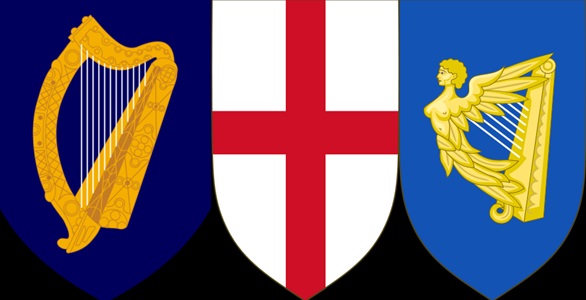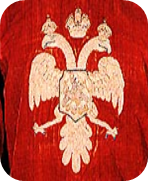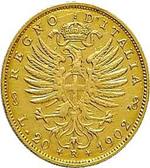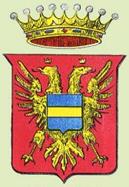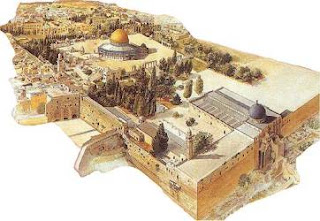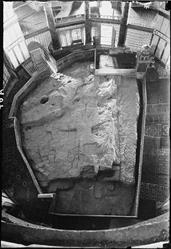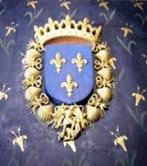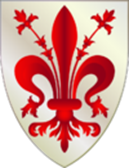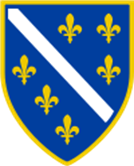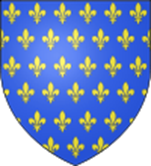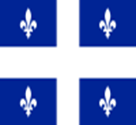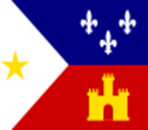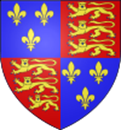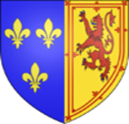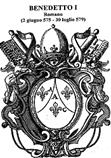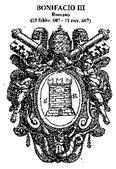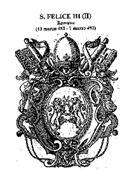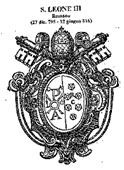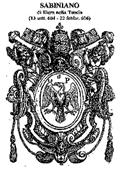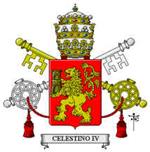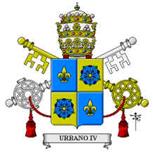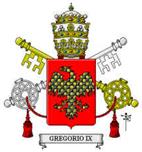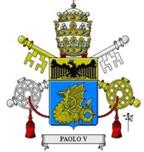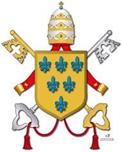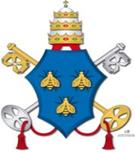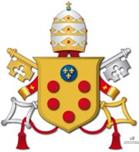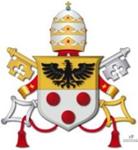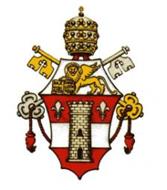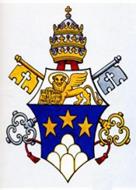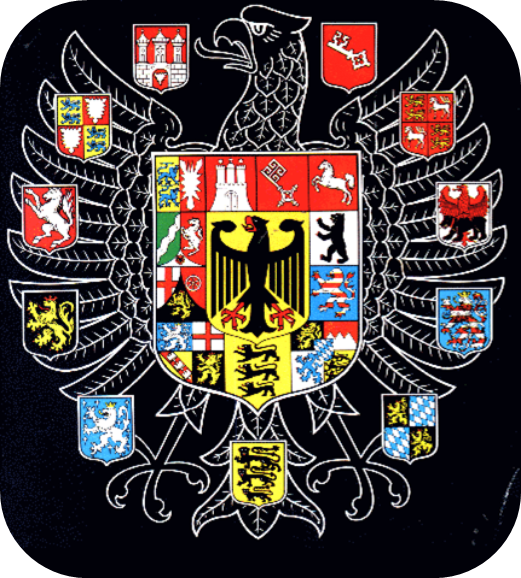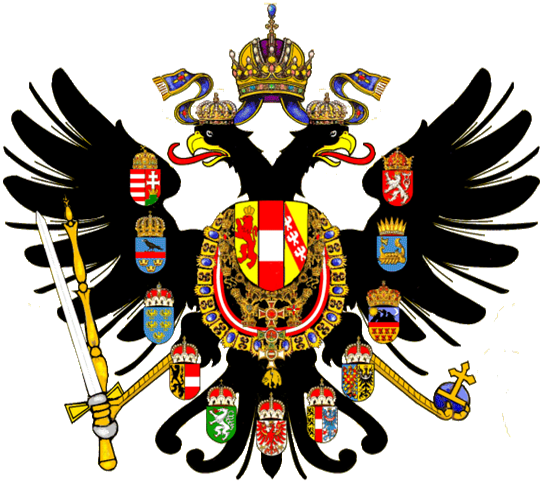In the Bible we find the first mention of the existence of symbols associated with single individuals and their families: “Every man of the children of Israel shall pitch by his own standard, with the ensign of their father’s house . . . and the children of Israel pitched by their standards, and so they set forward, every one after their families, according to the house of their fathers” (Numbers 2:2, 34). Every family in Israel, from the time of Moses, had its own standard.
It may be considered certain, therefore, that on their return from Babylonian exile, each of the twenty-four branches of the priestly family, who was party to the agreement arranged by Ezra, possessed its own standard. It may be considered equally certain that each group of descendants that entered into the secret organization (i.e. Mithraism) created in Rome by Josephus Flavius had in turn some symbols that distinguished it.
The Jews are very conservative people, therefore, these symbols must have always remained in use among the priestly families. By showing its symbol each member of a priestly family could be recognized by another throughout the Empire, and the rank he occupied in the hierarchy of the Mithraic organization was immediately understood. These same symbols were later certainly used in the heraldic coats of arms of those families.
|
Anguillara |
Alatri |
|
Amburgo |
Di Mosè |
|
De Rossi |
Soave |
Salmon |
Zarfatti |
Di Castro |
|
Pontecorvo |
Cohen |
Ghershom |
Corcos |
Castelli |
|
Perez |
Vakar |
Treves |
Baraffael |
Finzi |
A small sample of emblems of Jewish families (from Elvio Giuditta). All those symbols have been transferred on the coats of arms of the European aristocracy.
Main Symbols of Jewish Families
The most important symbols present in the coats of arms of the European aristocracy, lilies, roses, lions, eagles, towers, dragons, harps, stars and so on, they all were in use at the time of the reign of Judah. They therefore offer highly significant evidence in favor of the priestly theory, as they were symbols that identified Jewish families that migrated to Jerusalem after the destruction of the Temple of Jerusalem..
It is important to point out that some of these symbols have been revived in the modern state of Israel and are present in its insignia and on its coins—in particular, the Star of David, the pillar, the lily, and the harp. It is clearly not possible to assume that they were taken from European nobility’s symbolism; their roots undoubtedly lie in the most ancient Jewish traditions. It is from these traditions that the European nobility, which had the same origin, drew its heraldic symbols, and not vice versa.
The Lion
The emblem that can most clearly be connected to Jewish tradition is that of the lion, the symbol of Judah, the son of Jacob and ancestor of the Davidic dynasty. The lion was obviously the symbol of the kingdom of Judah itself, of which the Jewish priests represented the noble class. In particular, the lion must have been the symbol of royalty in Judah, and therefore one of the symbols used by the Hasmoneans in order to demonstrate their royal status.
Lions always appear in the coats of arms of English reigning houses and in many coats of arms of English noble families and cities. Together with the lily they became the symbol of the monarchy.
We find the lion of Judah in Belgium, Germany, Bohemia, and Czechoslovakia as the symbol of the nobility that was installed in that period by Charlemagne. Subsequently, we find it among the nobility and the reigning houses of Denmark, Norway, Sweden, and even Finland.
.
The lion is without doubt the symbol that takes, literally, the lion’s share in the coats of arms of the northern European reigning houses and nobility, and it indicates their membership in the priestly pool, both by direct origin and also due to the matrimonial policy typical of the family. Most of their countries have a lion on their coat of arms:
|
Flanders |
Brabant |
Norway |
Scotland |
|
Leon, Spain |
Denmark |
|
Augsburg |
The Eagle
The eagle is usually associated with imperial power, and in fact, all the European imperial families have an eagle in their coat of arms. According to common perception, its use is traced back to the Roman eagle, which was the symbol of the father of the gods, Jupiter, and was often used as an emblem of the Roman legions.
The eagle that appears in European coats of arms, however, is not the Roman one, but the Hasmonean eagle, which was engraved on the coins of the kingdom of Judah at the time of the Hasmoneans and was a main symbol of that reign, to the point that it was affixed at the entry of Jerusalem’s Temple.


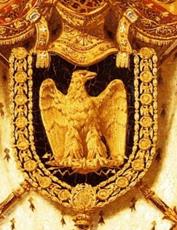
The Hasmonean eagle (left) on a coin of that epoch. At the center a double headed eagle engraved on a Jewish tomb in Venice. On the right the emblem of Napoleon I, maybe the only one in Europe with the Roman eagle
The eagle that appears on most European coats of arms is the Hasmonean.
|
Germany |
Russia |
Emblem of Otto IV |
Sacred Roman empire |
|
Iugoslavia |
Savoia family |
|
|
Some of the countless emblems with the symbol of the Hasmonean eagle. In particular all the imperial families have an eagle on their coat of arms

The Hasmonean eagle appears for the first time with Charlemagne. He used the symbol of the lily in his seals and other personal objects, and he used that of the Hasmonean eagle as well. The lily underlined his priestly condition (he considered himself to be a king-priest), and the eagle was very probably an individual emblem to show that he belonged to a royal breed.
The Dragon
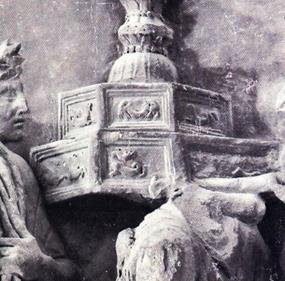

The dragon was a symbol of Jewish priestly origins. It was the symbol of the tribe of Dan. A dragon is represented on the base of the menorah on Titus’s triumphal arch. The dragon is omnipresent in Jewish, Essenian, and proto-Christian literature. In Revelation, for example, two chapters—12 and 13—are dedicated to the dragon, which also plays a key role in the outcome of the events. It is the symbol not only of the archangel Raphael, but also of Christian saints such as George, Theodorus, and Michael.
It became the emblem of Wales, as well of cities situated thousands of miles apart, like Venice (it was the emblem of its first patron saint, Theodorus, later replaced by the lion of St. Marc)
It also appears in the coats of arms of other royal and noble families, especially in northern Europe, in Denmark, Norway, and other countries around the Baltic Sea, where it was adopted by the Teutonic knights, from whom it passed to the Russian reigning dynasty (replaced afterwards by the two-headed Hasmonean eagle).
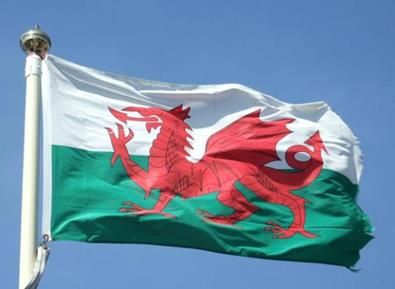
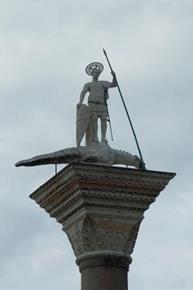
The flag of Wales, with a red dragon. On the right St. George and the dragon in St Marc square.
The Harp
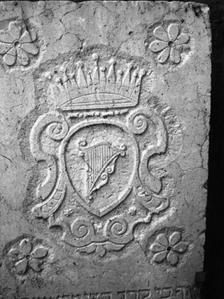

A harp on a Jewish tomb in Venice. On the right a harp on a modern Israeli coin
The Davidic harp is another symbol that is not of minor importance in the heraldry of families of royal and noble blood, especially in the British Isles. It is the symbol of Ireland and it therefore almost certainly dates back to the period of the conversion to Christianity of this island. It was presumably the emblem of the family of St. Patrick or at least of some member of the priestly family in his entourage who assumed a ruling position on the island.
From Ireland, the symbol of the harp was later taken to Scotland and became an integral part of the royal insignia of that country. Through Scotland, it also entered the royal coat of arms of England.
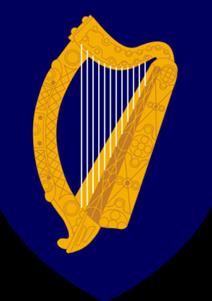
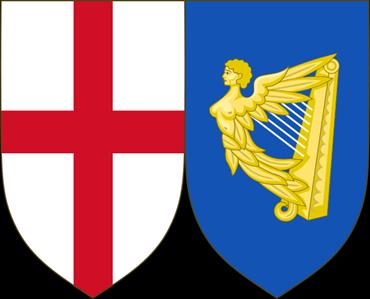
The royal emblem of Ireland (left). On the right the emblem of Commonwealth adopted on 1649
The Tower
The symbol of the tower does not have a clear relationship to the ancient Jewish tradition. Yet it very frequently appears in the emblems of ancient and modern Jewish families.
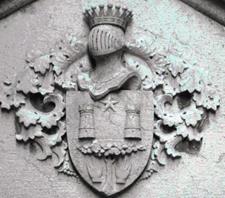
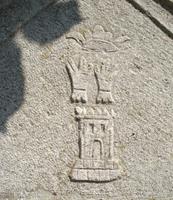
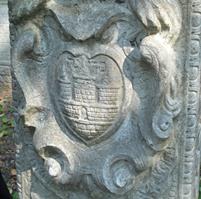
Family emblems in the ancient Jewish cemetery in Venice. The symbol of the tower is very frequent in Jewish emblems, often together with other classic Jewish symbols.
The symbol of the tower is wide spread throughout Spain and Italy, but it’s also present in Germany and it is frequent in the coats of arms of the popes.
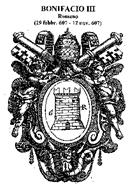
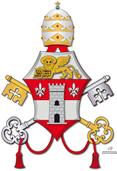
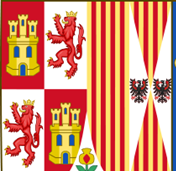
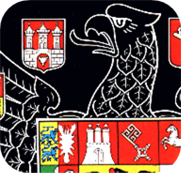
Symbols Referring to the Temple in Jerusalem
Among the symbols that we may consider to be priestly family emblems are some that appear to refer to the Temple of Jerusalem. Consequently, these symbols identified families who must have originally served in that Temple. The most explicit in this sense are the pillar, the mountain, and the checkered floor.
The Pillar
One of the most striking elements characterizing the Temple built by Solomon in Jerusalem were the two pillars, Jachin and Boaz, standing at its entrance. Therefore, it was natural and likely that the pillar would be taken as the emblem of a group of the priestly family that had originally served in that Temple.
The Jewish origin appears to be confirmed by the large number of Jewish families who have a pillar as their family symbol and by the fact that the pillar is also depicted on coins in modern Israel.
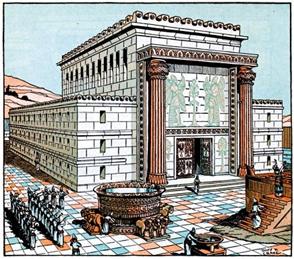
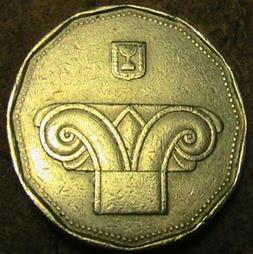
A model of Solomon Temple with the two pillars at the entrance. A pillar i salso represented on a
coin of modern Israel.
In the world of Christian nobles, the pillar is a symbol that was almost exclusively found among the Roman nobility linked to the church, like the great and well-known Colonna family.
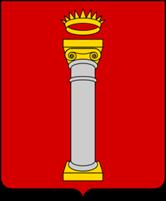

The Mountain
The mountain, like the pillar, is a symbol that appears almost exclusively in central Italy, in connection with the church. The symbol of the mountain was an indirect reference to the Temple of Jerusalem built at the top of Mount Moriah, which plays an important role in Jewish tradition. Membership in the priestly class of those who used this symbol is confirmed by the fact that the mountain is always depicted in groups of three or six, and the groups are arranged to form a triangle. This is an extremely transparent symbolism, which, as we will shortly see, alludes to the Divinity to whom the Temple of Jerusalem was dedicated.
The Temple-mound where Solomon temple was erected. On the right the Sakhrah, or the stone of the foundation, on the highest point of mount Morya
Various great families closely linked to the church have these mountains as their symbol. It is no coincidence that the same symbol characterizes a large number of Jewish families and also one of the greatest Italian banks—undoubtedly the oldest one—which took its name from this emblem.
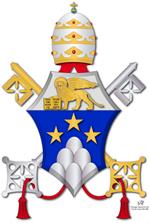
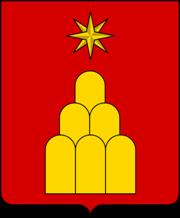
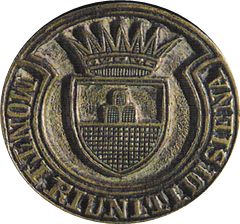
The coat of arms of John Paul I (left), of the Chigi family (center) and of the bank
Monte dei Paschi of Siena.
Checkered Floor
Another priestly symbol is the checkered floor. Its origin is traced back to the floor of the Holy of Holies in Jerusalem.
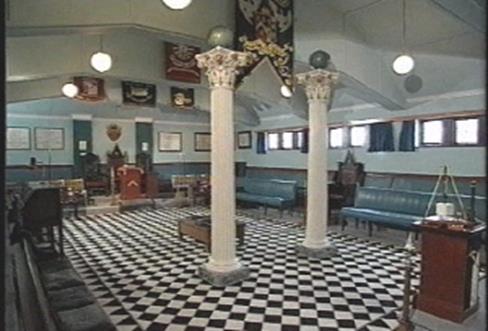
Checkered floor in a masonic temple, with the two columns Jachin and Boaz
It was presumably adopted by high priests to demonstrate their right of entry into the Holy of Holies. This, too, is a symbol originally limited to central Italy, and is closely connected to the church. We find the checkers superimposed on other heraldic figures of priestly derivation, such as the Hasmonean eagles of as many as five popes of the tenth century.
The checkerboard was the symbol of the Di Segni family of counts, who provided the church with popes. It is no coincidence that the Di Segni family is also a cohen family.
Checkers are also a symbol of the Cistercian monastic order created by Bernard of Clairvaux (religious orders adopted the heraldic symbol of their founder), the originator of the order of the Knights Templar.

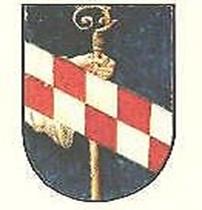
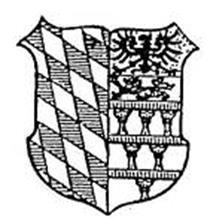
The checkered eagle of the Di Segni counts (left). On the right emblems of some monastic orders (Cistercian and Benedictine)
From the Cistercians, the checkers were evidently transferred to the Templars, and eventually, either directly or through the Templars, they entered into European heraldry.
Symbols of Membership in the Priestly Class
The triangle
Undoubtedly, the most widely used and widespread symbols in European heraldry are those that indicate not membership of a particular clan of Jewish origin, like those seen so far, but membership in the priestly order itself. These are symbols that represent the Divinity that was worshipped in the Temple of Jerusalem. They include the triangle; two triangles superimposed (also called the Star of David or Solomon’s Seal); and the five-pointed star. These symbols are very often suggested by the floral representations of the lily (hexagram) and the rose with five petals (pentagram). Furthermore, in a striking number of coats of arms, they are indicated only by the arrangement of the heraldic elements, which are repeated three times (forming an isosceles triangle), or six times (arranged to form a simple triangle—3, 2, 1—or a double one—1, 2, 2, 1).
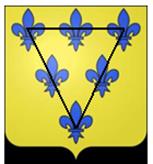
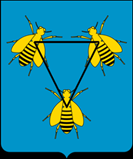
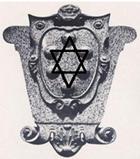
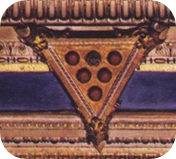
![]() Heraldic
symbol disposed to form a triangle or a double triangle. The two coats of arms
on the right belogn to the same Medicis family
Heraldic
symbol disposed to form a triangle or a double triangle. The two coats of arms
on the right belogn to the same Medicis family
Five-pointed Star
The five pointed star was a wide-spread symbol in ancient Judah’s kingdom. Although of Egyptian origin, it was adopted by many Jewish families.
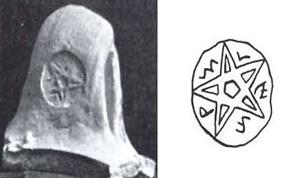
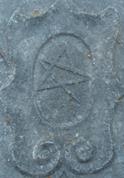
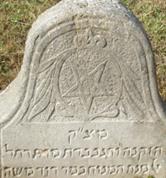
The five-pointed star, or pentagram, both explicitly and in the form of a rose with five petals (as we will shortly see), is the symbol that most frequently appears in places dedicated to Christian worship in the first millennium.
The Rose with Five Petals
The pentagram appears in a multiplicity of contexts, but no less frequent is the use, in its place, of the symbol that clearly represents it: the rose with five petals. Often, the rose is superimposed on five points, called thorns in heraldic language, which can be seen between the petals. While this suggestion is enough to transmit meaning, the pentagram is sometimes explicitly superimposed on the rose.
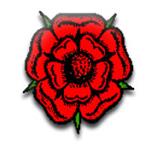
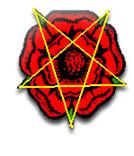
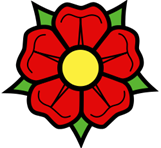
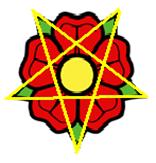
The rose is the symbol that recurs most frequently in Romanesque churches, convents, and monasteries. It is also the symbol of the so-called Comacini Masters, a brotherhood of architects who, starting from the period of the Lombards, took part for several centuries in the construction of churches and cathedrals in Italy and in northern Europe. Many consider them the precursors of the modern-day Masons.
The rose with five petals, either white or red, single or multiple, also appears in the coats of arms of many noble families. It was included among the symbols of royalty when it was adopted by the English houses of York and Lancaster, who long contended the throne of England during what were called the Wars of the Roses.
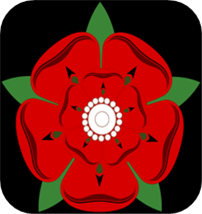
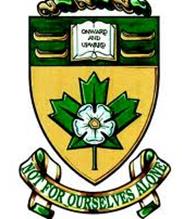
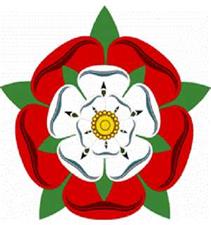
Coats of arms of Lancaster (left), York (center) and Tudor (right)
Yet it is also one of the symbols that appears most frequently not only in the coats of arms of Jewish and noble family groups linked to the church, but also in the heraldry of the church up to today. Five-pointed stars also distinguish objects dedicated to Christian worship, such as images of the Madonna, and even territorial and state-owned entities where Christian worship is, or originally was, prevalent.
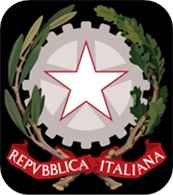
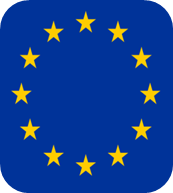
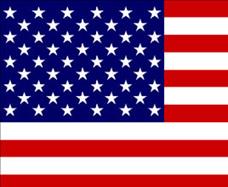
The emblem of Italy (left) and the flags of Europe and US
As we can expect, Italy is not the only country that is marked by the sign of the pentagram. In addition, the European Union and the United States of America are so marked. The stars that appear on their flags all have five points. This was not just a question of aesthetics; it was a precise choice with a deep symbolic meaning.
The Double Triangle (Six-Pointed Star)
The double triangle, or hexagram, togheter with the triangle it’s a priestly symbol that undoubtedly represents the Divinity. In Christianity in particular, the triangle has become the symbol of the Trinity, and above or behind the altar in practically all churches, it represents God. There is no doubt, however, that Christianity borrowed this from Jewish tradition, even if its most distant origin as a symbol of the Supreme Divinity can be found in ancient Egypt. The triangle, formed by hands or other elements (e.g., mountains) often appears in the coats of arms of cohen Jewish families, to underline their priestly status.
The highest expression of the Divinity in the Jewish world, however, was represented by two triangles superimposed to form a six-pointed star, also called the Star of David or Solomon’s Seal. The fact that it is a symbol of Jewish origin is proved not only by its name and by historical evidence, but also by the fact that it flies over the newly reconstituted state of Judah: Israel. In popular perception, the six-pointed star is essentially a Jewish symbol. Many might be surprised, therefore, to learn that it very frequently appears in Christian churches and cathedrals on floors and in friezes and in decorations of frontons and walls.
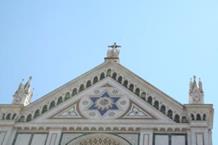
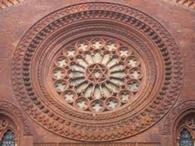
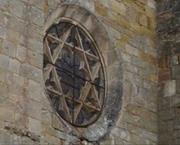
The six-pointed star appears not only in many Jewish family symbols, but also in a very large number of coats of arms of the church—from those of popes, cardinals and bishops to underline their priestly status to those of dioceses and religious institutions.
Less frequent is the explicit use of triangles, either double or single, in the heraldry of lay noble families. Yet the triangle remains the most universally used symbol in heraldry, and it appears in the vast majority of noble coats of arms, suggested by the geometric divisions of the coats of arms, and above all by the number and the arrangement of the heraldic elements in the coat of arms itself.
A great variety of symbols are used in heraldry besides those mentioned here—for example, balls, shells, and animals—which do not necessarily have a clear priestly meaning and are probably linked to some historical fact or even linked to the original profession of the family group. The priestly status is suggested by the fact that these symbols are mostly repeated in groups of three or six and arranged to form a triangle simple or double.
The Lily
The lily is the floral symbol which represents the hexagram. It is formed by six petals arranged in two groups of three superimposed in such a way as to create a perfect six-pointed star, and it is used in place of the Star of David and is meant to share its meaning. It reveals membership in the Jewish priestly family.
![]()

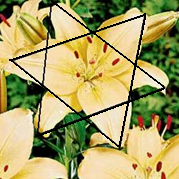
The lily was the symbol of Israel.
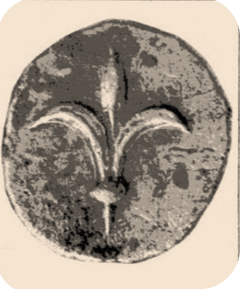
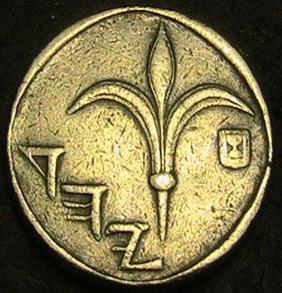
Hasmonean coin with the lily of Israel, the same reproduced on modern Israeli coins
One of the most widespread symbols in European heraldry is the lily, which, as we have seen, was the flower that symbolized ancient Israel, and thus appears today on the coins of the modern state of Israel. As the rose is the symbol that substitutes for the pentagram, so the lily represents the Star of David
It seems to have been used mainly by the descendants of the Pannonian branch of the Gens Flavia as a symbol of their divine right to govern. This branch had settled in central Europe in the second century. From the beginning, the lily imposes itself as the symbol of royalty. Its earliest documented use is by Flavius Anicius Carolus—Charlemagne—who included it on his clothes, scepter, crown, and seals (preserved in Rome). Lilies also appear repeatedly in the manuscripts of the Carolingians. That it was a symbol of priestly status rather than an emblem of a family clan is proved by the fact that, as we have seen, Charlemagne also used the symbol of the Hasmonean eagle, which was a family emblem.
There is no evidence that the lily was used by the Merovingians, in spite of the fact that artists of the fourteenth century, who identified the lily with royalty, painted the Merovingians with their clothes covered with lilies.
Charlemagne and his successors granted the privilege of using the symbol of the lily (or perhaps it would be more appropriate to say that they attached their property stamp on those cities) to dozens of cities in France, including Paris, Lille, Brest, Caen, Poitiers, Niort, Tours, Blois, Bordeaux, Angers, Orléans, Reims, Fréjus, Le Havre, Laon, and Versailles.
This privilege was also granted to some Italian cities. The most significant example is the city of Florence. Charlemagne allowed it to use the symbol of the lily, which he defined as the “illustrious flower of royalty.” On the occasion when it was adopted, the original name of the city was changed from Fluentia to Florentia.
|
Coat of arms of France |
The lily of Florence |
Emblem of Bosnia |
Coat of arms of the Capetians |
|
Emblem of Quebec |
The Acadian flag |
England 1405 |
Mary I of Scotland |
A small sample of the countless emblems with the lily
Crosses
A symbol that is frequently found among the European nobility and various religious institutes and orders is that of the cross, with all its forms and variants. Indeed, it could not be otherwise in a Europe that was formed under the aegis of Christianity—above all, if we consider the fact that heraldry developed in and was imposed on all Europe at the same time as the Crusades in which the symbol of the cross distinguished the Christian warriors who were opposed to the infidels. Many noble families adopted the symbol of the cross in order to testify to being champions of the faith, militant followers under the banner of Christ—even if they could just as well have laid claim to other symbols.
The cross is not in itself a symbol that indicates membership in the family of Jewish priestly origins and never appears as a symbol of Jewish families.
Membership in the priestly order, however, was often indicated by other elements combined with the cross itself, such as the lilies and triangles sometimes built up at their extremities
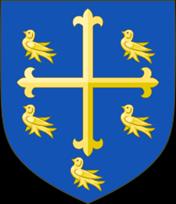
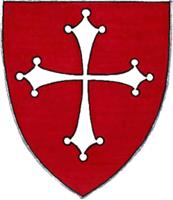
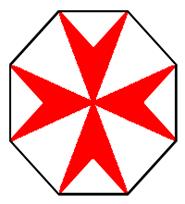
Emblem of Edward the Confessor (1066) on the left. Center: coat of arms of Pisa, with dotted triangles at the extremities. On the right the Templar cross.
Other Jewish symbols often present in the European coats of arms
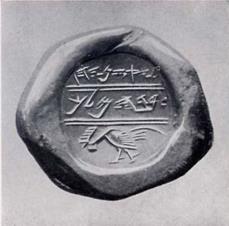
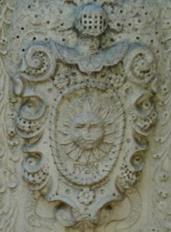
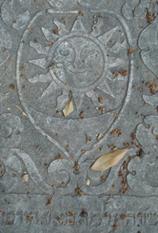
The cock in an ancient Jewish seal and the sun on Jewish tombs in Venice
Coats of arms of the popes always have priestly symbols
|
|
|
|
|
|
Coats of arms of early popes (sixth/seventh centuries) with most common priestly symbols
Coats of arms of European nationsAs we can see, most of the symbols are clearly of judaic origin and therefore identify priestly families. A few of them (horses, bears and so on) do not have a clear link with the Jewish tradition. They could identify families with non priestly origins.
Germany with all its landers
The imperial family of Augsburg with their domains
|
||||||||||||
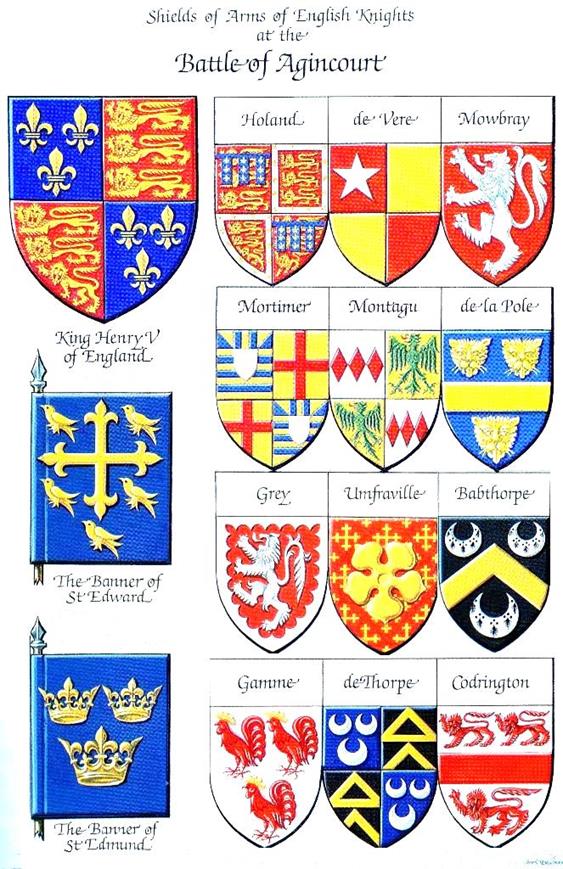
Coat of arms of England on 1554
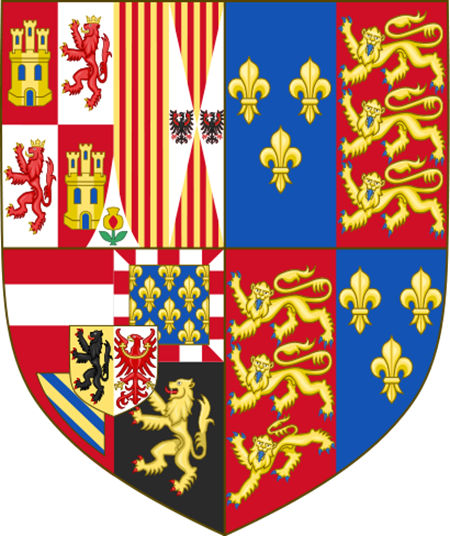
- Back: "home"
- Back to: "Moses"
- Buy a book

